File processing
File handling
You can upload your data in the customer's area (LogIn) with the function "upload" or send it via mail including your order numer at [email protected]. Additionally you can send us CDs or DVDs by post.
It's best if you send us your printable data in the final format 1:1 and in needed resolution to carry out your order as fast as possible.
If it is not possible for you to send us printable files we can create them for you. For further information, please contac us at [email protected].
Frequently asked questions / FAQ
What does printable mean?
Printable data are files that can be inserted directly in the RIP or files that can be directly printed.

Which file formats can be inserted in the RIP?
Digital- and largeformatprints: Established file formats are: EPS, AI, PDF*, TIFF, JPEG or PSD (reduced to one layer).
Foiltechniques / plotting: (window and car labeling)
For plotting suitable file formats are: EPS, AI, PDF*, .
JPG, TIFF, PSD und PDF*
JPG The file will be compressed so saving without loss of data is not possible, suitable for web,
low file size compared to TIFF
TIFF Loss-free saving, LZW-compression for faster file transfer, suitable for print
PSD photoshop format, please reduce it always to one layer / flatten image, large file size
PDF* PDFs should be conform to standard PDF / X-3:2002 and show the following characteristics:
- transparency, comments, password protection and form fields are not allowed
- OPI-comments and links are not allowed either
- transfer curves are not allowed
- pictures and fonts have to be embbeded completely
- pictures have to be reduced to one layer or rather don't consist of photoshop files with layers
for further information please visit www.pdfx3.org
* We can't assume del credere liability for prints of PDF files due to mistakes that take place while inserting data into the RIP or occur while creating the file. Fonts can be displaced or single elements won't be interpreted correctly under certain circumstances. So please send us an extra JPG as a preview for more certainty.

Up to what size can I send you data?
Our server takes up to 2 GB of data - if you want to send the files via mail they shouldn't be bigger
than 50 MB.

Which resolution should the file have?
300 dpi are used for offset printing and 20 to 150 dpi for large prints which also depends on the size of the print. The dpi value also differs according to your file, if pictures are embedded and if so, in which kind of quality, if it was taken by a digital camera or scanned. And maybe you used graphics (vector) and text?
We recommend the following resolutions:
| 0,25-2,5 m² | = 72-150 dpi |
| 2,5-5 m² | = 50-96 dpi |
| 5-10 m² | = 40-72 dpi |
| 10-20 m² | = 30-50 dpi |
| ab 20 m² | = 20-40 dpi |
The bigger the banner the bigger the viewing distance in general so the resolution of the file doesn't have to be too high.

What is the difference between Standard and Premium concerning banner prints?
The Standard print is suited for banner which are used for rack lining, advertisment on buildings and houses, logo displaying etc. Printing will be in a qualitiy of 300x300 dpi. Starting at 2m viewing distance, you will get a photorealistic impression.
The Premium print shows a higher resolution since the printing is done with 720x720 dpi. It's also fotorealistic in close-up range and often used for detailed graphics and pictures.
Settings
Should I apply bleed / trim?
No, that is not necessary.
Every print will be cut manually. Bleed / trim is needed for piled crop (i.e. offset printing).

Convert fonts to paths or curves
Please convert your fonts to paths or curves because we may not have the fonts you used for the layout.

Crop marks
Please don't apply crop or trim marks for digital printing. They are only needed for offsetprinting (i.e. flyer, cards, stationary)

Alpha channels / cutting paths
Also, don't make use of alpha channels, cutting paths and other masking techniques.

Din A format
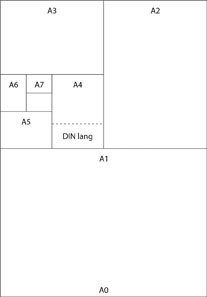 |
A0 | 841 × 1189 mm |
| A1 | 594 × 841 mm | |
| A2 | 420 × 594 mm | |
| A3 | 420 × 594 mm | |
| A4 | 210 × 297 mm | |
| A5 | 148 × 210 mm | |
| A6 | 105 × 148 mm | |
| A7 | 74 × 105 mm | |
| DIN lang | 111 × 220 mm |
Colors
What kind of color mode should the file be in?
Please create all files in color mode CMYK (8 bit).
CMYK is an abbreviation for the colors Cyan, Magenta, Yellow and Black which are used for printing. RBG (Red, Green and Blue) are colors of light and used for monitors and screens - this color range is bigger and includes brighter colors which can't be printed.

Gradients in large format printing
Adobe Illustrator or inDesign gradients based on vector will turn out a little streaky in large format printing due to technical restrictions, since it consists of max. 256 levels. This also depends on the length and the color of the gradient you choose, so the streaks will be more or less visible.
It helps if you create the gradients in Photoshop with the final measurements (1:1) or if you produce a ps. file from inDesign and convert it in Distiller to PDF.

Pantone and HKS
Spot colors such as Pantone and HKS aren't printable in digital print so please don't apply them. These colors will be rendered to CMYK.

Optimal values for black
The CMYK value 60 / 40 / 40 / 100 can be recomended for a deep black. Mixing Black with Cyan will achieve a deep and bright Black which is suitable for wide areas. Furthermore, the color appears to be ber compared to 0 / 0 / 0 / 100 Black.

How b is the color saturation in large format printing?
The outcome differs from the material that will be printed on.
The following materials posses a good color saturation: pvc-banner, poster, sticker, backlits.
Low saturated are textiles for example.
Textiles for flags are poorly saturated.

When and how does my colors change?
There will always be a permanent, chemical reaction which concludes in a change of colors, i.e. due to sun radiation. This reaction occurs to displays and banners that are placed inside (shop window, windows) as well. For example: red turns by and by to magenta. This way, new prints and reprints which were printed later on, will differ from the original colors of the first print. Please keep this in mind when ordering single sheets for already printed pop-up displays. To make sure to get the correct result, we recommend to order a proof beforehand.

Color anomalies concerning the same motive / picture / color beeing printed on different material
If you want to print the same motive (i.e. picture or color) on different printing material, for instance banner pvc and DekoTexx fabric, small color anomalies might occur.
Since the color affects the different materials in different ways, we recommend a proof on both materials if the colors must be exactly the same.
Also, we recommend to create a file with the size of DIN A3 with the desired color and varieties of it (i.e. 5% more cyan) so you could choose the optimal shades after seeing the proof. The article "proof" can be found in the category "Accessories".

Should I embed color profiles?
Actually no. Our RIP software uses Euroscala ISOcoated. Please note that other embedded profiles may cause color anomalies. The following color profiles can be used without problems: Coated Fogra 27 und ISOcoated v2.

Proofs
Of course you can order a contract proof to get an impression of your finished product. Your artwork will be proofed on the original material - for instance banner, polypropylene, poster, sticker, dreamtex - with identical settings for printing. You'll receive the proof in DIN A3.



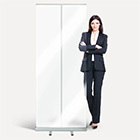 Hygiene protection
Hygiene protection 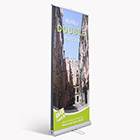 Bannerstands
Bannerstands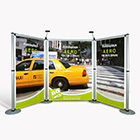 Exhibition Displays
Exhibition Displays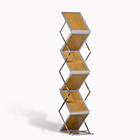 Brochure Stands
Brochure Stands 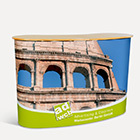 Counter
Counter  Cardboard Displays
Cardboard Displays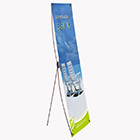 Banner Displays
Banner Displays 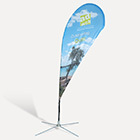 Outdoor
Outdoor 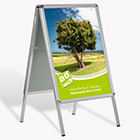 A-Boards
A-Boards 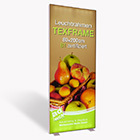 Illuminated displays
Illuminated displays 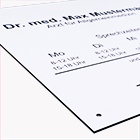 Sign Boards
Sign Boards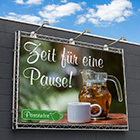 Banners
Banners 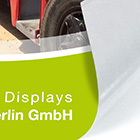 Sticker
Sticker 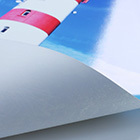 Posterprint
Posterprint  Reprints
Reprints 









